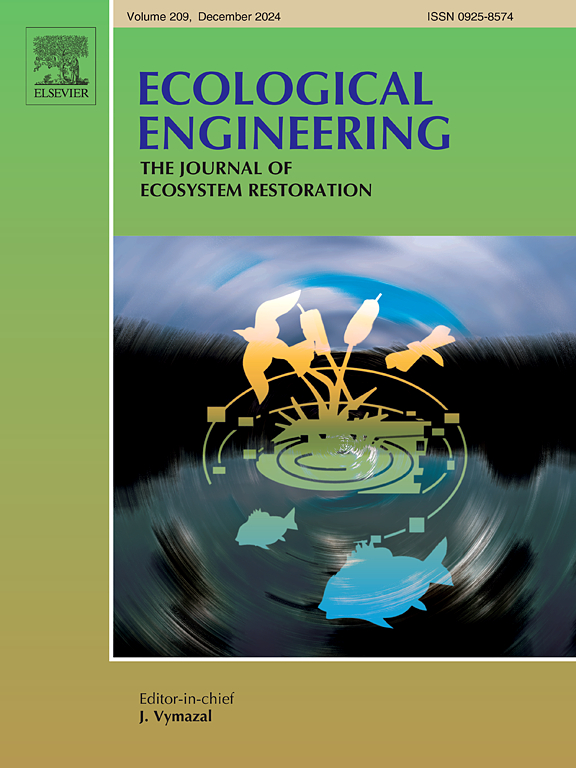生态工程建设中生态系统服务的权衡:中国25个水土保持工程的供方与受方评价
IF 4.1
2区 环境科学与生态学
Q1 ECOLOGY
引用次数: 0
摘要
中国最近雄心勃勃的生态目标推动了生态工程项目,其中一些项目因效率低下和生态系统服务(ESs)之间的权衡日益增加而面临批评。评估这些项目对于制定更可持续的解决方案至关重要。为了解决这一问题,我们开发了一个综合评估框架,将能量分析(捐助国方)和经济分析(受援方)相结合,以25个水土保持项目(SWCPs)为案例研究,评估五种关键生态系统服务(esv)的价值。应用偏最小二乘-结构方程模型(PLS-SEM)分析了措施因素(measures)、地形因素(terrain)、环境因素(environment)和气候因素(climate)等驱动因素之间的相互作用机制。结果表明,在swcp建设后,虽然总ESs值(ESVT)有所增加,但从能量和经济分析来看,节水效果都有所下降。除高仓河小流域外,所有swcp的固碳量均有所增加。两种方法的结果不一致,说明生态工程评价应同时考虑供方和受方。esv之间的权衡,尤其是在水土保持对中,表明swcp与当地ESs不协调。研究结果表明,超过一半的swcp的能源可持续性指数(ESI)下降,8个swcp的累积现值也下降。地形和气候是esv增加的主要驱动因素,而环境和措施对esv的负向影响最为显著。措施弱化了地形的积极作用,放大了环境的消极作用。最后,对优化生态建设提出了建议。本文章由计算机程序翻译,如有差异,请以英文原文为准。

Tradeoffs among ecosystem services under ecological engineering construction: Donor and receiver evaluation of 25 soil and water conservation projects in China
China's recent ambitious ecological goals have driven ecological engineering projects, some of which have faced criticism for inefficiency and increasing trade-offs among ecosystem services (ESs). Evaluating these projects is crucial for developing more sustainable solutions. To address this issue, we develop a comprehensive evaluation framework that combines emergy analysis (donor side) and economic analysis (receiver side) to assess the value of five key ecosystem services (ESVs) using 25 soil and water conservation projects (SWCPs) as case studies. Furthermore, we apply partial least squares-structural equation modeling (PLS-SEM) to analyze the interaction mechanisms among drivers, including measures factors (measures), terrain factors (terrain), environmental factors (environment), and climatic factors (climate). The results show that after the SWCPs construction, although increase in the total ESs value (ESVT) have been found, the decrease of water conservation is demonstrated from both emergy and economic analysis. Carbon sequestration increased in all studied SWCPs expect the Gaocang river small watershed. Inconsistent results from the two adopted methods suggest that the ecological engineering evaluation should consider from both donor side and receiver side. Tradeoffs among ESVs, most notably in soil retention and water conservation pair, suggest the SWCPs are uncoordinated with local ESs. Results derived from our proposed indicators show that the emergy sustainability index (ESI) of more than half of the studied SWCPs decreases, while the cumulative present value of 8 SWCPs also declines. Finally, we find that terrain and climate are the primary drivers of ESVs increases, whereas environment and measures have the most significant negative impacts. Measures weakens the positive effect of terrain while amplifying the negative effect of environment. Finally, suggestions toward optimized ecological construction were raised.
求助全文
通过发布文献求助,成功后即可免费获取论文全文。
去求助
来源期刊

Ecological Engineering
环境科学-工程:环境
CiteScore
8.00
自引率
5.30%
发文量
293
审稿时长
57 days
期刊介绍:
Ecological engineering has been defined as the design of ecosystems for the mutual benefit of humans and nature. The journal is meant for ecologists who, because of their research interests or occupation, are involved in designing, monitoring, or restoring ecosystems, and can serve as a bridge between ecologists and engineers.
Specific topics covered in the journal include: habitat reconstruction; ecotechnology; synthetic ecology; bioengineering; restoration ecology; ecology conservation; ecosystem rehabilitation; stream and river restoration; reclamation ecology; non-renewable resource conservation. Descriptions of specific applications of ecological engineering are acceptable only when situated within context of adding novelty to current research and emphasizing ecosystem restoration. We do not accept purely descriptive reports on ecosystem structures (such as vegetation surveys), purely physical assessment of materials that can be used for ecological restoration, small-model studies carried out in the laboratory or greenhouse with artificial (waste)water or crop studies, or case studies on conventional wastewater treatment and eutrophication that do not offer an ecosystem restoration approach within the paper.
 求助内容:
求助内容: 应助结果提醒方式:
应助结果提醒方式:


